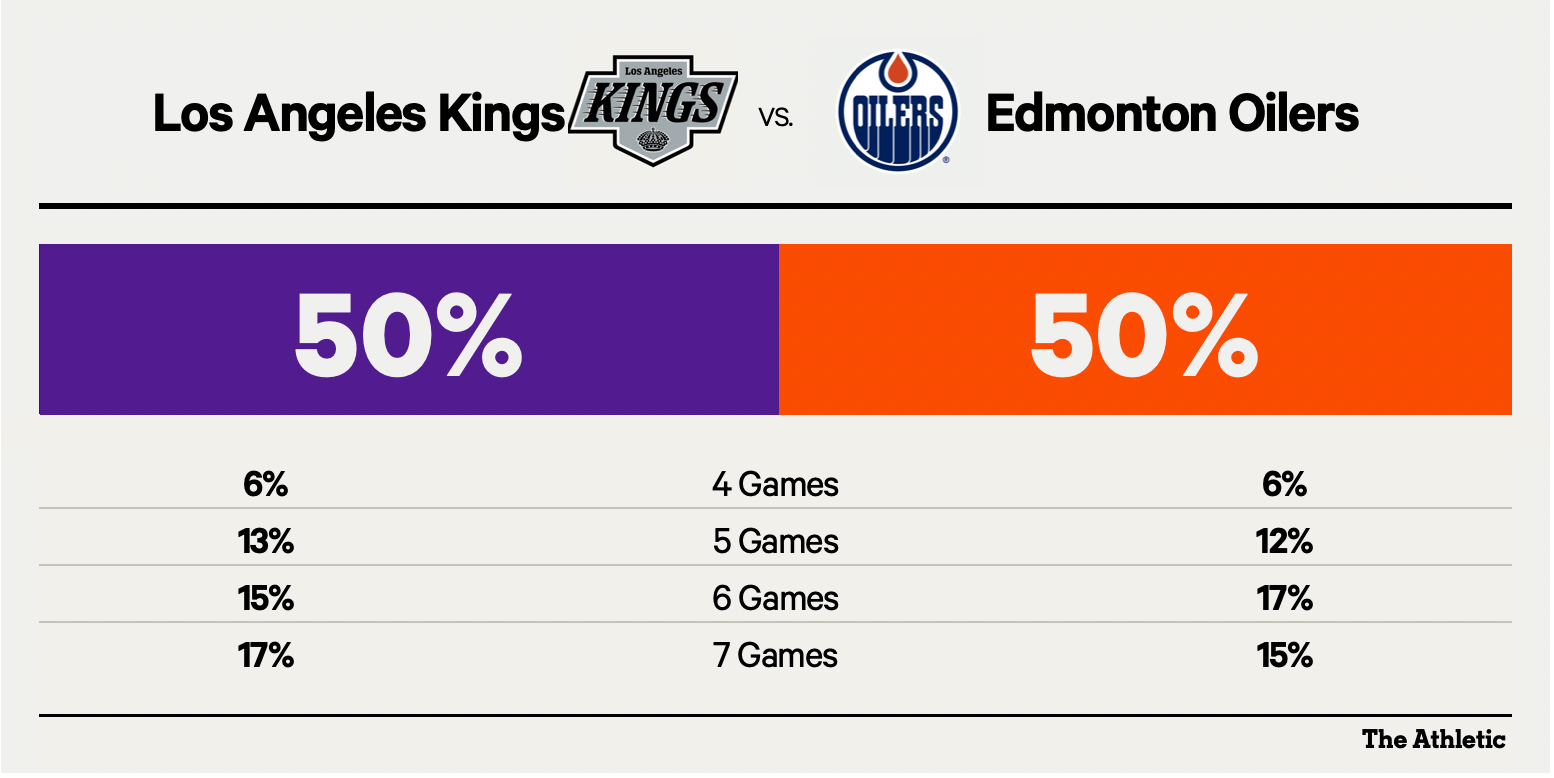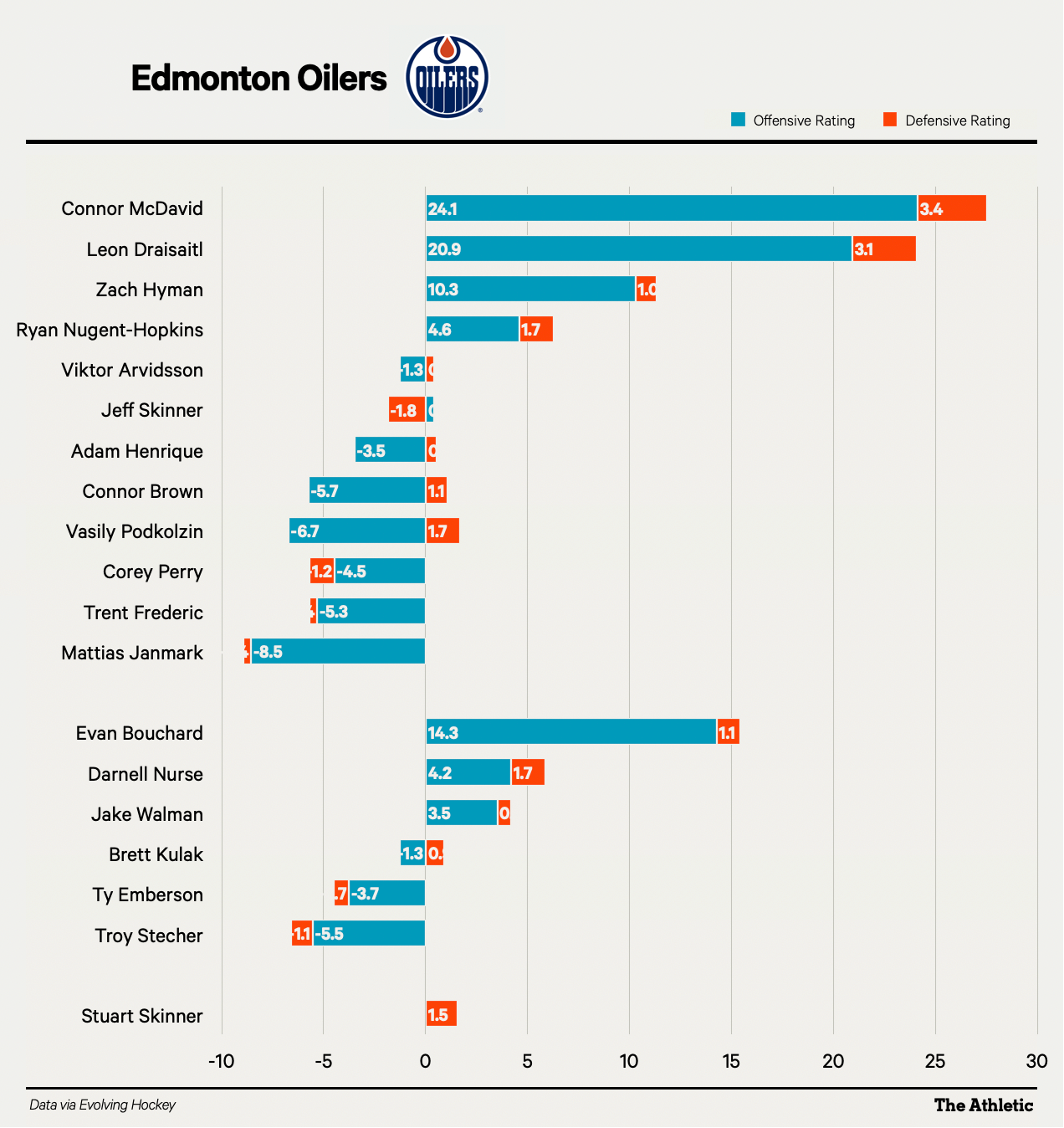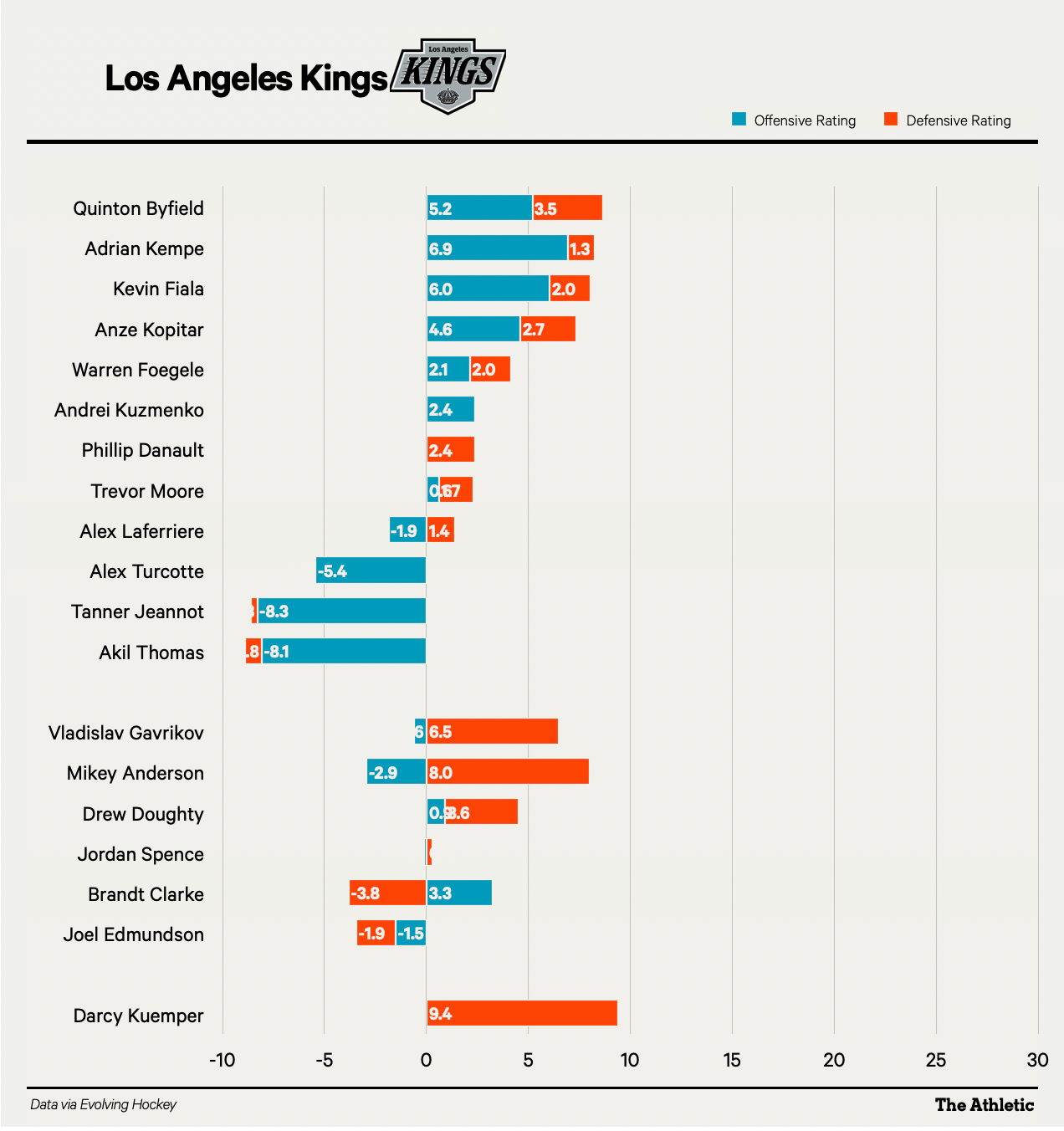
By Dom Luszczyszyn, Sean Gentille and Shayna Goldman
When the NHL moved to a divisional playoff in 2014, the main hook was leaning into regional rivalries by forcing repeat series within the bounds of the playoff structure. It’s a fine idea in theory and it’s led to a lot of marquee matchups. It may often seem unjust due to division discrepancies, but it’s also given us some entertaining hockey. That’s a win.
Advertisement
It’s also given us yet another series between the Los Angeles Kings and the Edmonton Oilers. The city of Los Angeles is hoping the fourth time’s the charm.
The odds
In each of the last three meetings between these two teams, the Oilers were heavy favorites, around 70 percent, winning each series in progressively fewer games. Over the last three playoffs, the gap between the Oilers and Kings seemed to grow even larger.
That’s changed this season. If ever there was a chance for the Kings to slay the dragon, this is it. The series is a dead heat, with the Kings holding a slight 50.2 percent edge.
Home ice plays a role here, as does Mattias Ekholm’s injury. With the Oilers at home and Ekholm in the lineup, they’d be right around 60 percent — much closer to the usual ballpark.
Closer, but not nearly as high. That’s because the Kings are better than the version the Oilers played a year ago. And the Oilers are also definitely worse.
The numbers
The story is the same between the Kings and Oilers. It’s a matchup between a defensive powerhouse and an elite offensive squad.
The Oilers’ plus-33 Offensive Rating ranks second among playoff teams; Connor McDavid, Leon Draisaitl and Evan Bouchard have a lot to do with that, as does Edmonton’s five-on-five play.
These two teams are neck-and-neck in expected goal share, ranking third and fourth in the league — their processes to get there are just different. The two are pretty even in the shot department; quality is where they separate. Edmonton is a more dangerous offensive team, with the second-highest expected goal creation of 2.88 per 60. The scoresheet doesn’t always reflect it, though, as the team has shot below 8 percent. The lack of tangible finishing ability is a big concern for the Oilers this time and is partly why their Offensive Rating has dropped precipitously compared to last season. It’s why this series is close.
Advertisement
The Kings, on the other hand, have the results to show for it — especially on home ice. While L.A. has outscored opponents 100-48 at home, its scoring isn’t as potent on the road. The real strength of this team is on the other end of the ice. The Kings are extremely stingy, with a league-low 2.13 xGA/60. Can they maintain that against the Oilers? Or will holes in Edmonton’s defensive coverage give a team like the Kings a chance to shine offensively?
Those same questions extend to special teams situations. The Kings suppress more chances and goals, but the Oilers have more weapons on the power play. A scoring rate of 9.07 GF/60 is low by their standards, but it beats the Kings’ bottom-10 rate of 6.3.
The big question
Can Quinton Byfield go toe-to-toe with the best in the world?
Quiton Byfield’s season — and really his last two — should serve as a reminder that progress isn’t always linear.
The No. 2 pick in 2020, Byfield spent his first three professional seasons making incremental gains but never quite breaking through. Each year, he spent a little more time in the NHL. Each year, he produced a little more.
In 2023-24, after shifting to the wing for his 21-year-old season, he popped, putting up 55 points and producing more efficiently than players like Jack Hughes, Nick Suzuki and Bo Horvat. Playing nearly all his minutes at left wing on a line with Anze Kopitar and Adrian Kempe, he also increased his offensive impacts overall, helping the Kings generate plenty of shots and chances and showing signs of a more fully rounded game.
That gave the Kings even more cover to ship out Pierre-Luc Dubois after a single, disastrous season in Los Angeles and move Byfield back to center on a full-time basis. The pump seemed primed for a second consecutive level-up season. Initial returns, though, weren’t great; Byfield had three goals and eight assists in his first 29 games. The Kings were winning his minutes, though, and he was on an unlucky streak — in that span, he was third on the team with 8.24 expected goals.
Advertisement
From mid-December to March 3, the shots began to fall, and he began to dial up his production; in those 30 mid-season games, he led Los Angeles in points (31), expected goals percentage (58.5) and goals percentage (67.6).
On March 5, though, he started a six-game goal streak — and a run of high-end production that lasted through the end of the regular season. In that span, he scored as many goals as Alex Ovechkin (14) and more than anyone in the NHL outside of John Tavares, Tage Thompson and Sidney Crosby. His underlying numbers at five-on-five have held steady, too; the Kings continue to decisively win his minutes.
The combination of Byfield between Kevin Fiala and Alex Laferriere has been one of the NHL’s best, with the Kings outscoring opponents 20-6 while they’re on the ice. Of the 79 line combos to play at least 200 minutes together in 2024-25, only Nathan MacKinnon between Martin Necas and Artturi Lehkonen had a higher goal percentage.
Fiala deserves some credit there; he’s been one of the league’s top playmaking wingers for several seasons, and 2024-25 has been no different. Still, what Byfield has done over the last month once again suggests he’s growing into the player the Kings always believed he’d be — and the player they need, if one of the NHL’s highest-profile streaks of futility is ever going to end.
Their best shot at overcoming Edmonton’s elite talent is to cultivate some of their own. Nobody is closer to fitting the bill than Byfield.
The X-factor
Can Darnell Nurse step up in Mattias Ekholm’s absence?
Ekholm’s injury, which will keep him out for the first round and perhaps beyond, is bad news for the Oilers. There’s no sense in pretending otherwise; he’s second among Edmonton’s defensemen in Net Rating, behind only Bouchard, and leads the group with a Defensive Rating of 1.9 despite playing against top competition. That’s quite a lot to lose.
Advertisement
It’ll fall on the rest of the Oilers’ blue line to make up the difference — and nobody more than Nurse, who’s rebounded from a disastrous 2024 postseason to show he’s capable of doing just that. Since Ekholm’s injury issue cropped up in early March (he’s played in seven of 21 games since March 1), Edmonton has put up an expected goal share of nearly 61 percent in Nurse’s minutes. He’s first among their defensemen in on-ice expected goals/60 (3.33) and second only to Ekholm in expected goals against/60 (2.12).
Playing Nurse with Bouchard and Jake Walman leads to higher-event hockey on both sides; playing him with Troy Stecher and Brett Kulak slows things down. In that regard, Edmonton has a choice to make with Nurse, but his overall results are strong post-March 1, regardless of his partner.
The rosters
By Net Rating, the best player in the world is McDavid (duh). Draisaitl, after the MVP-worthy season he’s had, is second. That one-two punch is hockey’s biggest advantage and the reason the Oilers are an annual contender. McDavid and Draisaitl are a force that’s difficult to stop, and these Kings know that firsthand.
Over the last three playoffs, McDavid has 36 points in 18 playoff games against the Kings while Draisaitl has 17 goals and 30 points. Despite being one of the league’s best defensive teams during that time, Edmonton’s dynamic duo still put up video game numbers against the Kings. Whether at five-on-five or on the power play, it didn’t seem to matter — McDavid and Draisaitl had their number.
Can that change this season? The Kings certainly have the personnel for it with three elite defensive centers and three elite defense defenders — we just need to see it actually happen first.
What works in Los Angeles’ favor is that the team’s defensive core has taken things up a notch this season. Mikey Anderson and Vladislav Gavrikov are now rated as two of the best defensive defensemen in hockey due to significant improvements in their defensive numbers. Anderson’s xGA/60 has gone from 2.21 last year to 1.97 this year, and the Kings allow just 1.39 GA/60 with him on the ice. Gavrikov’s jump has been even larger. Add Drew Doughty’s continued defensive excellence to that and the Kings have a three-headed monster that looks scarier than ever.
The same applies to their center core, though not to the same magnitude. With Byfield’s maturation in particular, the Kings look well-poised to stop anyone. Their first challenge, though, is the two guys they’ve failed to slow down for three straight seasons.
Advertisement
The path to victory for the Kings starts and ends there, because they have the edge otherwise. After Zach Hyman and Ryan Nugent-Hopkins — two usually strong forwards who have not lived up to expectations this season for Edmonton — the Kings’ depth shines in comparison. Kempe and Fiala are quality scorers, Warren Foegele has been a revelation and Laferriere and Trevor Moore have scored at 20-goal paces.
That’s firepower that the Oilers can’t compete with down the lineup. With Viktor Arvidsson and Jeff Skinner not working out as expected, there’s a massive drop-off in offensive talent after Nugent-Hopkins. And that’s saying a lot, considering Nugent-Hopkins has only scored at a 52-point pace this season.
Suffice to say, this isn’t the same explosive Oilers team we’re used to, and they’ll have it extra tough against this version of the Kings. If Los Angeles can slow down McDavid and Draisaitl even a little bit, the Kings’ depth advantage should be able to take care of the rest. In past years, when the Oilers were deeper, that equation wasn’t as simple, and the Oilers were heavy favorites for good reason. They were a team to fear even beyond their big two. That’s not the case this season.
The equalizer for the Oilers is their defense group, even without Ekholm. While the Kings’ big three on defense are all defensively elite, none of them can dependably drive offense. They lack the dynamic puck-moving instinct necessary to be offensive assets, and it’s the main reason the Kings aren’t an offensively gifted team despite their depth up front. Not trusting Brandt Clarke to play in the top four (for good reason, given his defensive inefficiencies) is part of that. That’s not the case for the Oilers, who have Bouchard, Nurse and Walman — a potent offensive trifecta that doesn’t sacrifice much defense to get there. No team creates more offense from the back end than the Oilers.
As poor as Edmonton’s forward group is, having a mobile defense puts them in more advantageous situations more often. For the team’s stars, it’s rocket fuel. Bouchard is the leader of that as one of the game’s very best offensive defensemen, though we’ll see how he fares without Ekholm by his side in a playoff setting. That’ll be a big defensive challenge for him, and while the model believes he’s equipped for that, a real-life pressure cooker could prove otherwise. For a defenseman so prone to making The Big Mistake, the first round will be a huge test.
The last piece of the puzzle is in net. In previous seasons, the Kings’ netminding situation looked just as much of an afterthought as the Oilers. This year, the way Darcy Kuemper has played down the stretch, it’s a real advantage. Kuemper has bounced back toward Vezina Trophy-caliber play, creating a healthy chasm between him and Stuart Skinner, his counterpart in Edmonton. The two have both played 50 or so games this year, and Kuemper has saved 24 more goals above expected in that time.
This matchup always comes down to McDavid and Draisaitl, but they weren’t the only reason for the Oilers’ success against Los Angeles. Edmonton’s depth was strong enough to leave the team’s star power as an overwhelming advantage. That’s not the case this time around.
Advertisement
The Oilers may have the three best players in this matchup, but that alone might not be enough. Thanks to Los Angeles’ depth advantage making up much of the gap, these rosters are much closer than usual.
The key matchup
Phillip Danault vs. Leon Draisaitl
With any Kings-Oilers matchup, the question is whether L.A.’s shutdown talent can contain the Oilers’ best. This year, that conversation starts with Draisaitl, who has been a force in all three zones.
On paper, the Kings have two advantages: home ice to drive the matchups and three shutdown options. But this could easily become a headache for them if things go south in Game 1. Danault likely opens the series in this matchup; he went head-to-head with Draisaitl at home earlier this season and has shouldered the toughest assignments since the 4 Nations Face-Off.
But if the coaches start swapping out centers for Game 2, it means things didn’t go according to plan with the first option, which is a sign of early trouble. That was the case last spring when the series shifted to L.A. — after a 6-1 loss in Game 3, McDavid matchups shifted from Danault to Kopitar.
The bottom line
If the Kings are going to pull this off, the time is now. Their depth and all-around game are stronger than ever, and the Oilers are limping into the postseason. Ultimately, though, it’s impossible to pick against McDavid and Draisaitl. Too much talent on one end and too much baggage on the other.
References
Understanding projection uncertainty
Resources
All Three Zones Tracking by Corey Sznajder
(Photo of Leon Draisaitl and Quinton Byfield: Gary A. Vasquez / Imagn Images)
This news was originally published on this post .










Be the first to leave a comment